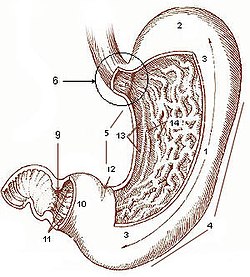| Angle of His | |
|---|---|
 The angle of His is formed between the esophagus (the tube arriving at the top of the image) and the cardia (position 6) The angle of His is formed between the esophagus (the tube arriving at the top of the image) and the cardia (position 6) | |
| Anatomical terminology[edit on Wikidata] |
The angle of His, also known as the esophagogastric angle, is the acute angle created between the cardia at the entrance to the stomach, and the esophagus. It helps to prevent acid reflux of stomach acid into the esophagus. It is commonly undeveloped in infants, making acid reflux more common.
Structure
The angle of His is the acute angle between the stomach and the esophagus. It is created by the collar sling fibres and the circular muscles around this gastroesophageal junction.
Variation
The angle of His is normally undeveloped in infants, with the esophagus making a vertical junction with the stomach. As a result, reflux of stomach contents is common.
Function
The angle of His forms an anatomical sphincter. This prevents the reflux of stomach acid, digestive enzymes, and duodenal bile from entering the esophagus. This is important in preventing gastroesophageal reflux disease and inflammation of the esophagus.
History
The angle of His is also known as the esophagogastric angle.
References
- Fujiwara, Yoshinori; Nakagawa, Kazuhiko; Kusunoki, Masato; Tanaka, Tsuneki; Yamamura, Takehira; Utsunomiya, Joji (1 January 1998). "Gastroesophageal reflux after distal gastrectomy: possible significance of the angle of His". The American Journal of Gastroenterology. 93 (1): 11–15. doi:10.1016/S0002-9270(97)00002-6. ISSN 0002-9270.
- Josef Fischer; K.I. Bland. Mastery of surgery, Volume 1. p. 719.
- ^ Sircar, Sabyasachi. (2008). Principles of medical physiology. Stuttgart: Thieme. p. 435. ISBN 978-1-58890-572-7. OCLC 187294914.
- Dick, R. C. S.; Hurst, Arthur (1 April 1942). "Chronic Peptic Ulcer of the Oesophagus and ITS Association with Congenitally Short Oesophagus and Diaphragmatic Hernia". QJM: An International Journal of Medicine. 11 (2): 105–120. doi:10.1093/oxfordjournals.qjmed.a066387. ISSN 1460-2725.
- ^ Hiatal Hernia eMedicine Retrieved 30 January 2010
- Berman, J. K.; Berman, E. J.; Lalonde, A. H. (1 March 1961). "Management of Esophageal Hiatus Hernia Syndrome and Associated Abnormalities with Balanced Operations". Diseases of the Chest. 39 (3): 233–248. doi:10.1378/chest.39.3.233. ISSN 0096-0217.
| Anatomy of the gastrointestinal tract, excluding the mouth | |||||||||||||||||||||
|---|---|---|---|---|---|---|---|---|---|---|---|---|---|---|---|---|---|---|---|---|---|
| Upper |
| ||||||||||||||||||||
| Lower |
| ||||||||||||||||||||
| Wall | |||||||||||||||||||||